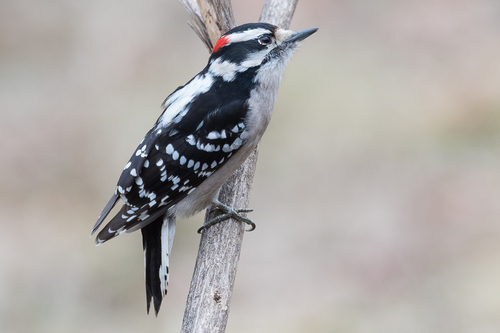
Downy Woodpecker
The Downy Woodpecker (*Dryobates pubescens*) is the smallest woodpecker species in North America. Known for its diminutive size and bold black-and-white plumage, it's a common sight at backyard feeders and in woodlands across the continent. This adaptable bird plays a vital ecological role by controlling insect populations, particularly wood-boring beetles and other forest pests. It is not generally considered to be of significant cultural importance, but its widespread presence and familiarity make it a well-loved species among birdwatchers.
14-18 cm
Length
25-30 cm
Wingspan
Least Concern
Conservation Status
Distribution
The Downy Woodpecker is widely distributed across North America, ranging from Alaska and Canada south to the southern United States, excluding some of the most arid regions of the Southwest. It does not undertake long-distance migrations, though some northern populations may move slightly south in winter.
Lifespan
Average lifespan in the wild is 1-2 years, though some individuals can live up to 10-11 years.
Downy Woodpecker's Habitat
Habitat Types
Deciduous forests, Mixed woodlands, Orchards, Parks, Suburban gardens
Climate Zones
Temperate, Boreal, Subtropical
Adaptations
Downy Woodpeckers possess strong, chisel-like bills for excavating wood and extracting insects. They also have stiff tail feathers that act as a prop when climbing tree trunks, and a long, barbed tongue for reaching insects deep within crevices.
Variations
Several subspecies are recognized, differing slightly in size and plumage, particularly in the amount of white spotting on the wings and back. These variations are often clinal, meaning they change gradually over a geographic area.
Appearance
Breeding Plumage
Plumage remains relatively consistent throughout the year.
Seasonal Feather Changes
Minor wear and fading may occur, but there are no distinct seasonal changes in plumage.
Sex Based Plumage Differences
Males have a small red patch on the nape (back of the head), which is absent in females.
Notable Features
Black and white checkered back, White underparts, Black wings with white spotting, Small size compared to other woodpeckers
Diet and Feeding
Primary Foods
Insects, Larvae, Beetles, Ants, Caterpillars, Seeds, Berries, Nuts
Foraging Behavior
Downy Woodpeckers primarily forage on tree trunks and branches, using their bills to peck and probe for insects. They also glean insects from leaves and occasionally feed on the ground. They are frequent visitors to suet feeders.
Specializations
Their strong, chisel-like bill and long, barbed tongue are adaptations for extracting insects from wood. They also have specialized skull and neck musculature to absorb the shock of repeated pecking.
Seasonal Diet Variations
In winter, when insects are less abundant, Downy Woodpeckers consume more seeds, berries, and nuts. They will readily take suet from bird feeders.
Behavior
Social Structure
Downy Woodpeckers are generally solitary or found in pairs, especially during the breeding season. They may join mixed-species foraging flocks in winter.
Communication
A sharp 'pik' call, A whinnying rattle, Drumming on wood
Migration
Downy Woodpeckers are generally non-migratory, although some northern populations may move short distances south in response to severe weather or food shortages.
Territorial or Group Behaviors
They defend breeding territories during the nesting season. Outside of the breeding season, they are less territorial but may still defend favored feeding sites.
Conservation
Threats
Habitat loss, Forest fragmentation, Use of pesticides
Protection Programs
Habitat conservation and restoration efforts, Sustainable forestry practices
Local National Laws
Protected under the Migratory Bird Treaty Act in the United States.
Population Trend
Stable
Population Estimates
The global population is estimated to be around 13 million individuals.
Interesting Facts
They can drum on trees at a rate of up to 16 beats per second.
Drumming is used for communication, attracting mates, and establishing territory.
Downy Woodpeckers sometimes follow Pileated Woodpeckers to feed on insects exposed by the larger woodpecker's excavations.
This is an example of commensalism, where one species benefits from the actions of another without harming it.
They have been known to excavate nest cavities in wooden fence posts and even utility poles.
This demonstrates their adaptability to human-altered landscapes.
Faqs about Downy Woodpecker
How can I attract Downy Woodpeckers to my yard?
Provide suet feeders, sunflower seeds, and peanuts. Planting native trees and shrubs can also provide natural food sources and nesting sites.
What is the difference between a Downy Woodpecker and a Hairy Woodpecker?
Hairy Woodpeckers are larger than Downy Woodpeckers and have a longer bill relative to their head size. Hairy Woodpeckers also lack the black spots on their outer tail feathers, which are present in Downy Woodpeckers.
Do Downy Woodpeckers damage trees?
Downy Woodpeckers primarily target dead or dying trees, and their foraging helps control insect populations that can damage trees. They rarely cause significant harm to healthy trees.
What should I do if I find an injured Downy Woodpecker?
Contact a local wildlife rehabilitator or veterinarian. It is illegal to possess or care for wild birds without the proper permits. Consult a professional for medical or expert advice.
Copyright @ Nature Style Limited. All Rights Reserved.
 English
English